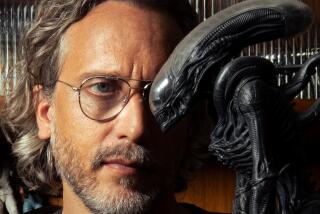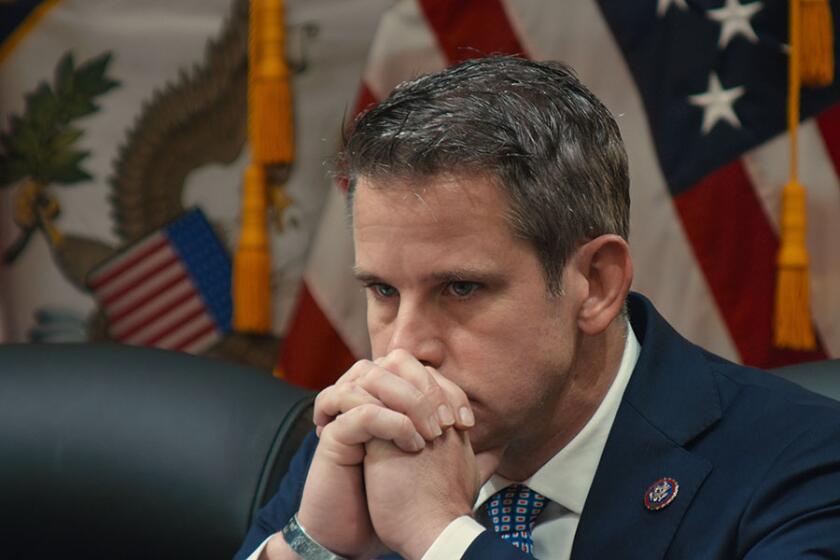Seclusion Has Left Lucas Out of Touch
Just before George Lucas reissued his “Star Wars” movies to celebrate the 20th anniversary of the original film’s 1977 release, I flew up to his Skywalker Ranch for a rare audience with the publicity-shy filmmaker. It was a gloomy winter day, and I remember sitting in his office, waiting for him to arrive, studying a painting that depicted, in elaborate detail, the enmeshed gears inside a clock. For Lucas, the painting represented the triumph of craftsmanship.
“I guess that’s what fascinates me,” he said. “The way a 16th century clockmaker would build a complicated clock. I’m a person who makes things that are intricate. Whether you’re a clockmaker or a filmmaker, that’s what you do--you create things that work.”
I thought of Lucas’ painting after seeing his new “Star Wars” prequel, “Episode II Attack of the Clones,” which like its immediate predecessor, “Episode I The Phantom Menace,” is a bitter disappointment for anyone with an abiding affection for Lucas’ original trilogy of futurist fantasies. Like the painting, Lucas’ new movies are packed with meticulous visual detail. But they are a forlorn triumph of mechanics--they have no spirit or soul. Even worse, they look like the work of a director who’s used the miracle of modern computer technology to wall himself off from the messy unpredictability of the outside world.
It’s what happens when an artist works in creative isolation. Success is often the worst thing that can happen to a filmmaker. The brash self-confidence that artists use for emotional support often mutates into an arrogance that cuts them off from their audience--and themselves.
Millions of fans have already seen “Attack of the Clones,” (it grossed $110.2 million in its first four days) lining up, as the New York Times’ A. O. Scott put it, “out of habit and compulsion, like weary Brezhnev-era Muscovites.” But something has gone horribly wrong. What has drained the new movies of their magic? Sad to say, the fault lies not in the stars, but with their creator.
Lucas should never have directed the movies himself. After “Phantom Menace” arrived with a thud, the filmmaker’s defenders said he was simply rusty--he hadn’t directed a movie since the original “Star Wars.” Things would be better next time. Well, they aren’t. Like its predecessor, “Clones” is missing what we crave from great films--vibrant storytelling, narrative clarity, compelling drama and good acting (with exemptions granted to Ewan McGregor and Christopher Lee).
For all its state-of-the-art technology, “Clones” has an air of musty nostalgia; it lacks the emotional intensity of “The Lord of the Rings: The Fellowship of the Ring” or the playful verve of “Spider- Man.” Outside of a few inspiring action sequences and a crowd-pleasing light-saber duel between Yoda and the evil Count Dooku, the movie has no sense of pacing. It’s slowed by endless plot exposition, portentous foreshadowing and a series of hapless romantic encounters between Hayden Christensen and Natalie Portman.
To be blunt, “Star Wars” doesn’t need Lucas behind the camera any more than the James Bond series needed original 007 director Terence Young to survive. The second and third “Star Wars” films did just fine in the hands of journeymen directors Irvin Kershner and Richard Marquand. The new movies would’ve benefited from independent-minded younger directors who might have challenged some of Lucas’ cobwebby creative impulses.
Lucas’ best work was made with strong collaborators: Lawrence Kasdan, for example, wrote “Raiders of the Lost Ark” and was a co-writer on “Empire Strikes Back” and “Return of the Jedi.”
As he proved in the “Indiana Jones” movies (Lucas produced them along with director Steven Spielberg) and in the development of Industrial Light and Magic, the industry’s top special-effects company, Lucas’ talents are probably better suited as a conceptual thinker and producer than director. He’s never liked directing anyway. Harrison Ford said that when he was shooting “Star Wars,” the only direction Lucas gave him was, “OK, same thing, only better” and “Faster, more intense.”
Editing was Lucas’ first love. As his old friend film editor Walter Murch once told me: “George only became a director so he could have better material to edit.”
The ‘Random Chaos’ of Filmmaking
Murch, a buddy from Lucas’ film school days who probably understands his psyche as well as anyone, is convinced that Lucas turned his back on directing for more than two decades because he abhorred what Murch calls the “random chaos” of filmmaking.
“If you told George you’d invented a marvelous new machine where you could attach a set of electrodes to your temple lobes and simply think the film into the machine, and it would come out exactly the way you imagined it in your head, he’d buy it and get rid of everything else in an instant.”
In fact, Lucas did the next best thing: He created ILM, which, along with Lucas’ pioneering efforts in digital video, has allowed him to shift much of his energy to post-production, where he can deal with computer animators instead of ornery actors or unpredictable weather, thereby cutting down considerably on the level of random chaos. The results have changed the shape of cinema.
Most of this summer’s big movies are packed with fantasy heroes and special effects inspired in large part by the “Star Wars” and “Indiana Jones” series, and 3-D computer animation has also been the driving force in children’s films like “Toy Story” and “Monsters, Inc.,” both creations of Pixar, a company started by Lucas that he later sold to Steve Jobs.
But the differences between the ways Lucas and Pixar pursue ideas are striking. At Pixar, collaboration and self-criticism are an integral part of the process. On several Pixar movies, including “Toy Story 2,” the company stopped the projects in mid-development, throwing out huge chunks of story lines and fixing other elements before forging ahead.
Lucas works in seclusion. Whatever feedback he receives is from friends and underlings, not peers. No one seems to deliver bad news. He told reporters recently that problems with “Phantom Menace” were “totally in the media [and] not based on fact.... I wouldn’t change anything about it.”
It’s telling that Lucas appeared shocked that people took offense to “Phantom Menace’s” Jar Jar Binks, the bumbling animated character who sounds like a Jamaican resort pool boy. Lucas dismissed the charges of racial stereotyping as “ridiculous” and blamed them on newspaper stories, saying none of his black friends had taken offense.
Presidents and corporate tycoons lose touch with reality just as often as filmmakers. But it’s especially painful to watch artists who were once so plugged into the culture fall so out of touch. It’s happened to Woody Allen and Martin Scorsese, two cinema gods whose recent movies have been woefully self-absorbed and emotionally stunted.
But no one is more isolated than Lucas. Set on 6,000 acres of rolling hills in rural Marin County, his sprawling Skywalker Ranch is like 19th century Japan--a wonderland cut off from the rest of the world. It has its own inn, yoga studio, horse stables, vineyard and fire department.
Seeing the mock 19th century California winery buildings after being waved through by a guard wearing a Skywalker Fire Brigade arm patch, you feel as if you’ve stumbled onto the set of Lucas’ version of “The Truman Show.” The buildings’ designs are based on a Lucas short story about an imaginary 19th century railroad tycoon building his dream homestead.
When Lucas and Spielberg were preparing “Raiders of the Lost Ark,” they spent an afternoon in a Universal screening room, watching episodes of “Don Winslow of the Navy,” one of their beloved 1940s adventure yarns. But their childhood memories had tricked them--the serials were appallingly bad. Spielberg was so depressed he almost quit the project. Lucas shook his head, saying, “Geez, these things sure don’t hold up after 25 years.”
I hate to be the one to tell you, George, but when people watch “Attack of the Clones” 25 years from now, they’re going to feel the same way.
*
“The Big Picture” runs every Tuesday in Calendar. If you have comments, ideas or criticism, e-mail them to [email protected].
More to Read
Only good movies
Get the Indie Focus newsletter, Mark Olsen's weekly guide to the world of cinema.
You may occasionally receive promotional content from the Los Angeles Times.










